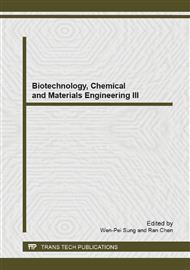[1]
Gupta S K, Majumdar S, Bhattacharya TK. Ghosh TC, Studies on the relationships between the synonymous codon usage and protein secondary structural units,J. Biochem Biophys Res Commun. Vol. 269(2000)(3): 692-6.
DOI: 10.1006/bbrc.2000.2351
Google Scholar
[2]
Sharp P M, and W H Li, The rate of synonymous substitution inenterobacterial genes is inversely related to codon usage bias, MolBiol Evol, Vol. 4, pp.222-230, (1987).
DOI: 10.1093/oxfordjournals.molbev.a040443
Google Scholar
[3]
Xie T, Ding D, The relationship between synonymous codon usage and protein structure, FEBS Letters, Vol. 434, (1998). 93-96.
DOI: 10.1016/s0014-5793(98)01160-0
Google Scholar
[4]
Suzuki H, Brown C J, Forney L J, Top E M. Comparison of correspondence analysis methods for synonymous codon usage in bacteria. DNA Res. (2008); 15: 357–65.
DOI: 10.1093/dnares/dsn028
Google Scholar
[5]
Gu W, Zhou T, Ma J, Sun X, Lu Z. The relationship between synonymous codon usage and protein structure in Escherichia coli and Homo sapiens. Biosystems. Feb (2004 )73(2): 89-97.
DOI: 10.1016/j.biosystems.2003.10.001
Google Scholar
[6]
Gouy M and C Gauier. Codon usage in bacteria: correlation with gene expressivity, J . Acids Research, Vol. 10, (1982)7055-7074.
DOI: 10.1093/nar/10.22.7055
Google Scholar
[7]
Wan X F, Xu D, Kleinhofs A, and J Z Zhou. Quantitative relationship between synonymous codon usage bias and GC composition across unicellular genomes, J, BMC Evolutionary Biology (2004), 4: 19.
Google Scholar
[8]
Mukhopadhyay P, Basak S, Ghosh T C,Synonymous codon usage in different protein secondary structural classes of human genes: implication for increased non-randomness of GC3 rich genes towards protein stability,J . Biosci, Vol. 32(2007)5: 947-63.
DOI: 10.1007/s12038-007-0095-z
Google Scholar
[9]
Lee S, Weonl S, etc. Relative Codon Adaptation Index, a Sensitive Measure of Codon Usage Bias,J. Evolutionary Bioinformatics (2010): 6 47–55.
DOI: 10.4137/ebo.s4608
Google Scholar
[10]
Sharp P M, and W H Li. The codon adaptation index-a measure of directional synonymous codon usage bias, and its potential applications, Nucleic Acids Research, (1987): Vol. 15. 1281-1295.
DOI: 10.1093/nar/15.3.1281
Google Scholar
[11]
Ruiz LM, Armengol G, Habeych E, Orduz S. A theoretical analysis of codon adaptation index of the Boophilus microplus bm86 gene directed to the optimization of a DNA vaccine. J Theor Biol. (2006); 239: 445–9.
DOI: 10.1016/j.jtbi.2005.08.009
Google Scholar
[12]
Prejit, Rajesh Kumar Agarwal, etc. Evaluation of recombinant outer membrane protein based vaccine against Salmonella Typhimurium in birds, J. Biologicals. (2013): Vol. 41 162-8.
DOI: 10.1016/j.biologicals.2013.01.003
Google Scholar
[13]
Ismael S, Constantino L M, etc. Salmonella porins induce a sustained, lifelong specific bactericidal antibody memory response,J. Immunology (2006): 117(1) 59-70.
DOI: 10.1111/j.1365-2567.2005.02263.x
Google Scholar
[14]
Arockiasamy A., Murthy G S, etc. Conformational epitope mapping of OmpC, a major cell surface antigen from Samonella typhi[J],Structural Biology,(2004): 148: 22-33.
DOI: 10.1016/j.jsb.2004.03.011
Google Scholar
[15]
Richa Jha, Anil Kumar, etc. Cloning, Sequencing and In Silico Analysis of Omp C of Salmonella Typhimurium,J. ISRN Veterinary Science, (2012): 105402-8.
DOI: 10.5402/2012/512848
Google Scholar
[16]
Barrow1 P A, Freitas Neto O C. Pullorum disease and fowl typhoid - new thoughts on old diseases: a review, J. Avian Pathology, (2011): Vol. 40(1) 1-3.
DOI: 10.1080/03079457.2010.542575
Google Scholar
[17]
Richa Jha, 1 Anil Kumar etc. Cloning, Sequencing and In Silico Analysis of Omp C of Salmonella Typhimurium.J. ISRN Veterinary ScienceVolume, Article ID 512848, 7 pages.
DOI: 10.5402/2012/512848
Google Scholar
[18]
Bibb M J, Findlay P R, and M W Johnson. The relationship between base composition and codon usage in bacterial genes and its use for thesimple and reliable identification of protein-coding sequences, Gene, (1984): Vol. 30, pp.157-66.
DOI: 10.1016/0378-1119(84)90116-1
Google Scholar
[19]
Ikemura T. Codon usage and tRNA content in unicellular and multicellular organisms,J. Mol Biol Evol, (1985): Vol. 2, pp.13-34.
DOI: 10.1093/oxfordjournals.molbev.a040335
Google Scholar
[20]
Jia M, and Y Li. The relationship among gene expression, folding free energy and codon usage bias in Escherichia coli, FEBS Letters, (2005): Vol. 579, pp.5333-5337.
DOI: 10.1016/j.febslet.2005.08.059
Google Scholar
[21]
Eyre-Walker A. Synonymous codon bias is related to gene length in Escherichia coli: selection for translational accuracy?, Mol Biol Evol, (1996): Vol. 13, pp.864-872.
DOI: 10.1093/oxfordjournals.molbev.a025646
Google Scholar
[22]
Sauvage C, Bierne N, Lapegue S, and P Boudry. Single Nucleotide polymorphisms and their relationship to codon usage bias in the Pacific oyster Crassostrea gigas, Gene, (2007): Vol. 406, pp.13-22.
DOI: 10.1016/j.gene.2007.05.011
Google Scholar
[23]
Kotlar D, and Y Lavner. The action of selection on codon bias in the human genome is related to frequency, complexity, and chronology of amino acids. (2006): BMC Genomics. 7: 67.
DOI: 10.1186/1471-2164-7-67
Google Scholar
[24]
Jansen R, Bussemaker H J, and Gerstein M. Revisiting the codon adaptation index from a whole-genome perspective: analyzing the relationship between gene expression and codon occurrence in yeast using a variety of models. Nucleic Acids Res. (2003).
DOI: 10.1093/nar/gkg306
Google Scholar
[25]
Das S, Roymondal U, Sahoo S. Analyzing gene expression from relative codon usage bias in Yeast genome: a statistical significance and biological relevance. (2009): Aug 15; 443(1-2): 121-3.
DOI: 10.1016/j.gene.2009.04.022
Google Scholar


